The Georgia Bulldogs football program has reached a stratospheric milestone that few college athletic departments could ever dream of: a valuation approaching a staggering \$2 billion. In a sport long known for its pageantry, prestige, and power, Georgia’s meteoric rise to the financial summit is both a testament to its recent dominance on the field and a reflection of the massive economic engine that college football has become. More than just a top-tier football team, Georgia now finds itself the envy of the collegiate sports world, embodying the blend of tradition, business acumen, and competitive excellence that define a true juggernaut.
Not long ago, college football was viewed through a simpler lens, where pageantry, tailgating, and regional pride defined success just as much as wins and losses. But in the modern era—especially with the evolution of media rights, name-image-likeness (NIL) deals, and conference realignment—the sport has evolved into a billion-dollar enterprise, and the Georgia Bulldogs are standing firmly atop that gold-laden mountain. According to new financial reports and estimations from leading valuation analysts and sports economists, the Georgia Bulldogs football program is now worth close to \$2 billion, making it one of the most valuable sports programs in the entire world, not just in the NCAA.
This valuation isn’t some abstract hypothetical figure—it’s based on hard metrics: revenue generation, brand strength, fan base size, media rights, licensing agreements, and future earning potential. Georgia’s rapid ascent in financial clout mirrors its on-field success, with back-to-back national championships in 2021 and 2022 setting the tone for an era of dominance under head coach Kirby Smart. Those titles weren’t just symbolic trophies for the trophy case—they were jet fuel for a brand that was already ascending into the college football stratosphere. Add in consistent Top 5 recruiting classes, sell-out crowds at Sanford Stadium, and lucrative apparel partnerships, and it’s easy to understand how Georgia has become college football’s premier blue-chip stock.
One of the key elements behind Georgia’s mind-blowing valuation is its fan engagement. Bulldog Nation is no longer confined to the southeastern United States—it has gone global. Whether it’s the packed stands in Athens on Saturdays or massive viewership numbers during prime-time broadcasts, Georgia fans have demonstrated a willingness to spend, support, and sustain the program at an elite level. With an average attendance of over 92,000 per game and a donor base that has fueled massive facility upgrades, Georgia isn’t just playing football—it’s operating a business empire. This loyal and ever-expanding fanbase ensures that the program’s revenue streams remain robust and resilient, even during off-seasons or rebuilding years.
Then there’s the matter of recruiting. Georgia has become the premier destination for the nation’s top high school talent. From five-star quarterbacks to dominant edge rushers and versatile defensive backs, the program has created a recruiting pipeline that is unrivaled. That recruiting success translates directly into winning, and winning, in turn, drives merchandise sales, TV deals, and brand partnerships. When a recruit commits to Georgia now, they aren’t just joining a football team—they’re entering a sports business ecosystem that rivals many professional franchises.
Facilities are another pillar propping up Georgia’s near-\$2 billion valuation. The program has invested heavily in creating a football experience that rivals any NFL operation. The Butts-Mehre Heritage Hall renovation, new indoor practice facilities, state-of-the-art recovery and performance centers, and locker rooms that look like luxury suites are all evidence of Georgia’s commitment to excellence off the field. These infrastructure improvements do more than attract recruits—they also impress donors, alumni, and media partners who see a first-class operation worthy of investment.
In the modern age of college football, television rights and media exposure are perhaps the most valuable commodities of all. Georgia has consistently been a ratings magnet, and its marquee matchups draw millions of viewers across the country. Whether it’s SEC Saturdays, College GameDay appearances, or playoff showdowns, Georgia is frequently in the spotlight. That kind of visibility doesn’t just feed the ego of a fanbase—it feeds a valuation. Broadcasters and streaming platforms are clamoring to ink deals that feature Georgia prominently, ensuring that the revenue keeps rolling in.
Moreover, Georgia’s place within the SEC adds another layer to its valuation. The Southeastern Conference has long been considered the crown jewel of college football, and its recent expansion—adding programs like Texas and Oklahoma—only bolsters that claim. The new SEC media rights deal with ESPN and ABC is worth billions, and Georgia stands to gain significantly from the conference’s collective bargaining power. Being a flagship program within such a powerful league means Georgia is not only maximizing current revenue opportunities but is also perfectly positioned for future windfalls as the media landscape continues to evolve.
Another critical factor in Georgia’s ballooning valuation is the explosion of NIL opportunities. While NIL is still in its relative infancy, Georgia has been proactive in building a robust infrastructure that allows its athletes to capitalize on their personal brands without compromising the integrity of the program. The university’s partnerships with local businesses, national brands, and digital platforms have created a NIL ecosystem that supports player empowerment while simultaneously elevating the program’s reputation among recruits. A high NIL valuation often correlates with overall program valuation, and Georgia has emerged as a leader in this space.
From a branding perspective, Georgia’s image has never been stronger. The bold red and black uniforms, the iconic “G” logo, and the aura of “between the hedges” have transcended regional identity and become national symbols of excellence. The program has leveraged its heritage to connect with older fans while using modern media strategies—including a dominant presence on social media—to capture the attention of Gen Z. In an era where brand equity is as valuable as box scores, Georgia has positioned itself as a 21st-century powerhouse.
It would also be impossible to ignore the impact of head coach Kirby Smart in this meteoric rise. Hired in 2015, Smart has not only delivered championships but has also fundamentally transformed the culture and business model of Georgia football. His relentless attention to detail, recruiting acumen, and commitment to building a sustainable program have paid off in both wins and dollars. Smart has effectively turned Georgia into the Alabama of the new era, combining Saban-esque discipline with a fresh energy that resonates with players and fans alike. In the business world, he would be considered a CEO of a Fortune 500 company—and rightly so.
The valuation nearing \$2 billion is more than just a headline-grabbing number—it represents a seismic shift in how we understand college athletics. Georgia is now functioning at a level that blurs the line between amateur and professional sports, operating more like a professional franchise than a traditional university team. With NIL, media rights, donor engagement, and global branding in play, Georgia is not just competing for championships—it’s competing for market dominance. And with every passing season, it becomes more apparent that the Bulldogs are building a dynasty that could rival the greatest in sports history.
Critics may argue that these valuations represent a troubling commercialization of college sports. After all, football programs are still attached to academic institutions, and the explosion of money can raise concerns about priorities. But Georgia has found a way to balance both worlds. The football program’s success has had a ripple effect across the university, boosting enrollment applications, increasing alumni donations, and enhancing the school’s national profile. In many ways, the \$2 billion valuation reflects the total value Georgia football brings to the broader UGA ecosystem.
As we look ahead, the question isn’t whether Georgia will sustain this valuation—it’s whether it will grow even larger. With playoff expansion on the horizon, new revenue opportunities emerging from international broadcasting, and the continued integration of digital and NIL platforms, Georgia could be well on its way to becoming the first college football program to break the \$2.5 billion mark. What was once unthinkable—a college team outpacing professional franchises in valuation—now feels not only possible but likely.
In the ever-evolving landscape of college athletics, the Georgia Bulldogs are more than just a success story—they are the standard. A program that wins with class, dominates the airwaves, nurtures elite talent, and now commands a financial footprint that would make Fortune 500 CEOs blush. The nearly \$2 billion valuation is not a fluke. It’s a forecast of a future that’s already unfolding in Athens. One where the Bulldogs not only bark—they roar with the power of an empire.



